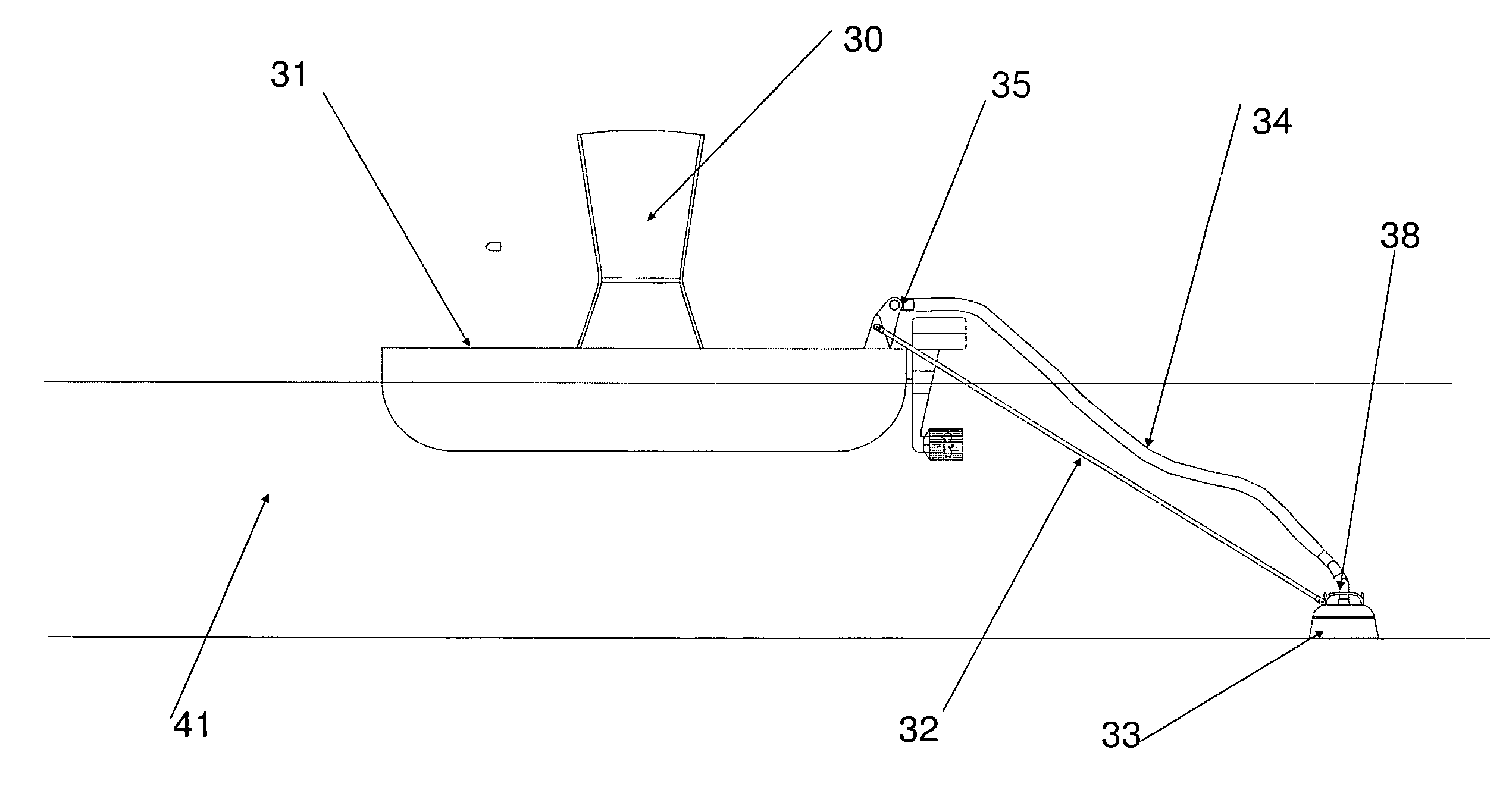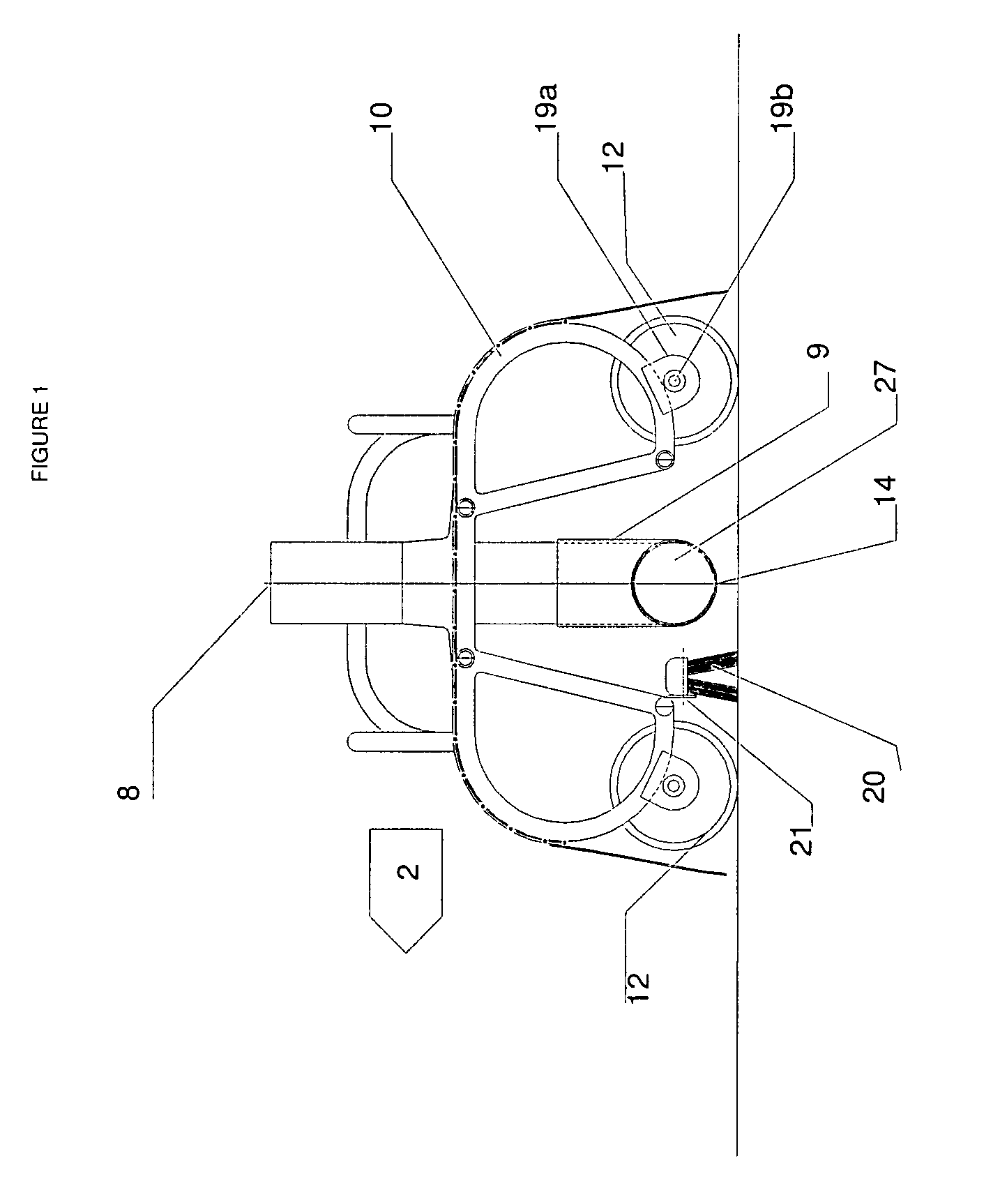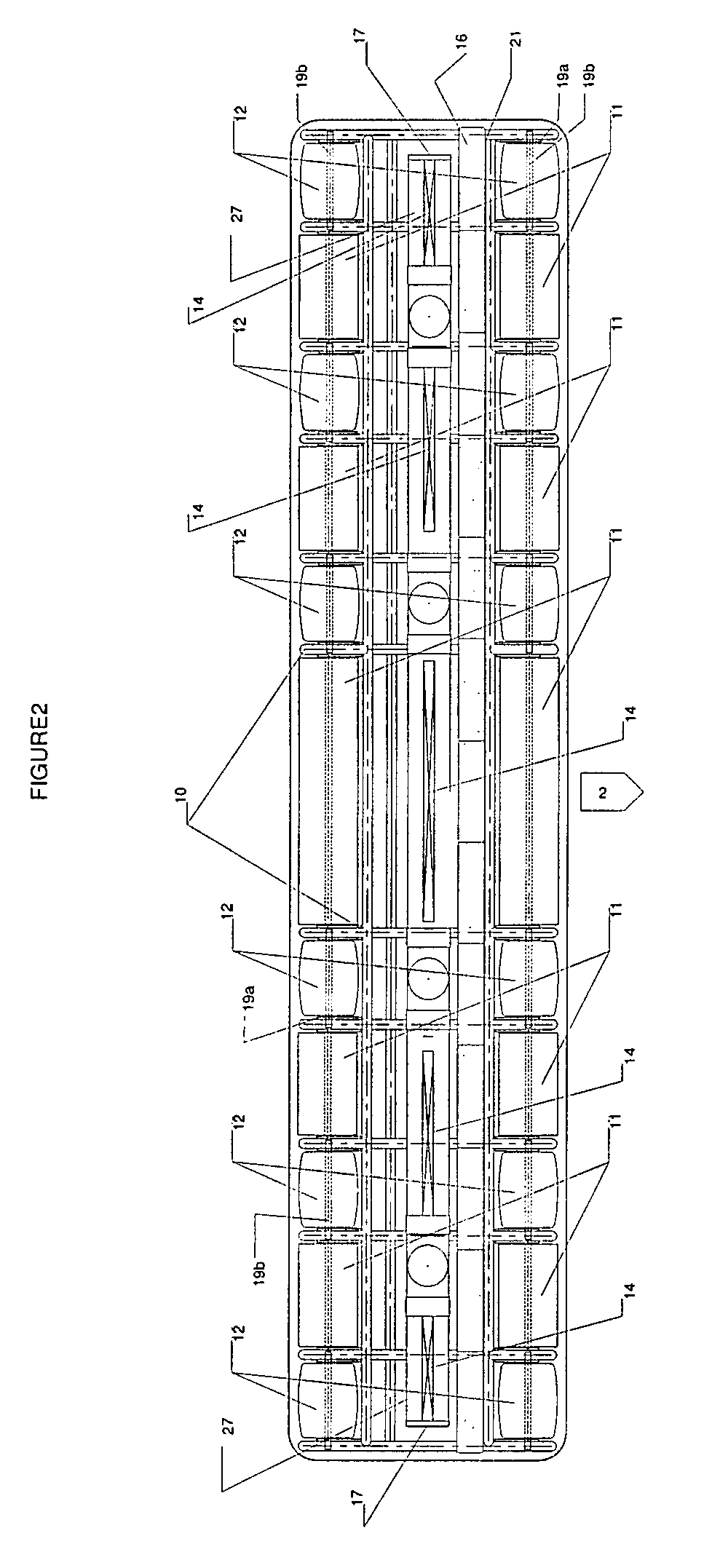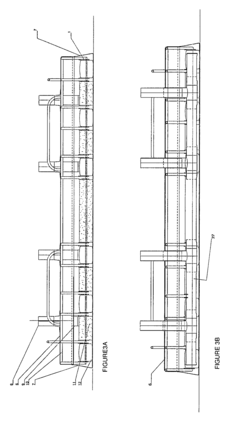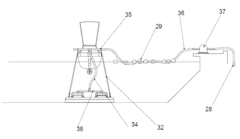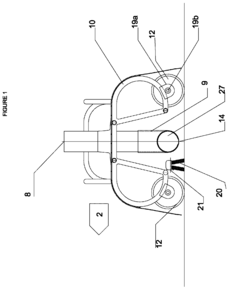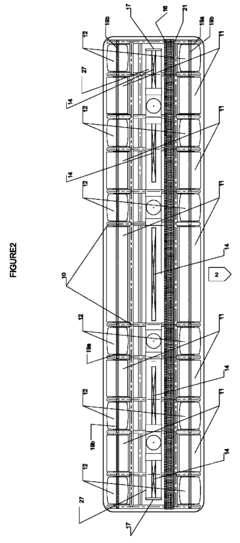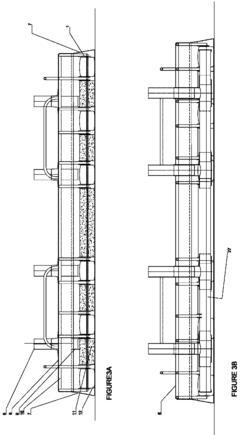How Nitrification Contributes To Algal Blooms?
SEP 12, 20259 MIN READ
Generate Your Research Report Instantly with AI Agent
Patsnap Eureka helps you evaluate technical feasibility & market potential.
Nitrification Process Background and Research Objectives
Nitrification represents a critical biogeochemical process within the nitrogen cycle, involving the oxidation of ammonia to nitrite and subsequently to nitrate by specific groups of microorganisms. This process has been extensively studied since the late 19th century when Sergei Winogradsky first identified the chemoautotrophic bacteria responsible for nitrification. Over the past decades, our understanding of nitrification has evolved significantly, revealing its complex ecological implications, particularly in aquatic ecosystems where it plays a pivotal role in nutrient dynamics.
The historical trajectory of nitrification research has shifted from basic microbiological characterization to ecosystem-level impacts, with increasing focus on its contribution to environmental challenges such as eutrophication and harmful algal blooms (HABs). Recent technological advances in molecular biology, metagenomics, and biogeochemical modeling have revolutionized our ability to monitor and understand nitrification processes across diverse environments.
Current technological trends in this field include the development of advanced sensors for real-time monitoring of nitrification rates in natural waters, improved molecular techniques for identifying and quantifying nitrifying microorganisms, and sophisticated ecosystem models that integrate nitrification with other biogeochemical processes. These innovations are enabling more precise predictions of how nitrification influences nutrient availability for primary producers, including potentially harmful algae.
The primary objective of this technical research is to elucidate the mechanistic relationships between nitrification processes and the formation, persistence, and severity of algal blooms in freshwater and marine ecosystems. Specifically, we aim to identify the critical thresholds and environmental conditions under which nitrification significantly contributes to algal bloom development through altered nitrogen speciation and availability.
Secondary objectives include quantifying the relative contribution of nitrification to total bioavailable nitrogen in bloom-prone environments, characterizing the temporal dynamics between nitrification rates and bloom formation, and evaluating how anthropogenic factors such as agricultural runoff and wastewater discharge influence these relationships. Additionally, we seek to assess how climate change factors, including rising temperatures and altered precipitation patterns, may modify nitrification processes and subsequently impact algal bloom frequency and intensity.
This research addresses a significant knowledge gap in understanding the complete nitrogen pathway from anthropogenic inputs to algal utilization, with particular emphasis on the intermediary role of nitrification. By clarifying these relationships, we aim to develop more effective predictive models and management strategies for mitigating harmful algal blooms across diverse aquatic ecosystems, ultimately contributing to improved water quality management and ecosystem health.
The historical trajectory of nitrification research has shifted from basic microbiological characterization to ecosystem-level impacts, with increasing focus on its contribution to environmental challenges such as eutrophication and harmful algal blooms (HABs). Recent technological advances in molecular biology, metagenomics, and biogeochemical modeling have revolutionized our ability to monitor and understand nitrification processes across diverse environments.
Current technological trends in this field include the development of advanced sensors for real-time monitoring of nitrification rates in natural waters, improved molecular techniques for identifying and quantifying nitrifying microorganisms, and sophisticated ecosystem models that integrate nitrification with other biogeochemical processes. These innovations are enabling more precise predictions of how nitrification influences nutrient availability for primary producers, including potentially harmful algae.
The primary objective of this technical research is to elucidate the mechanistic relationships between nitrification processes and the formation, persistence, and severity of algal blooms in freshwater and marine ecosystems. Specifically, we aim to identify the critical thresholds and environmental conditions under which nitrification significantly contributes to algal bloom development through altered nitrogen speciation and availability.
Secondary objectives include quantifying the relative contribution of nitrification to total bioavailable nitrogen in bloom-prone environments, characterizing the temporal dynamics between nitrification rates and bloom formation, and evaluating how anthropogenic factors such as agricultural runoff and wastewater discharge influence these relationships. Additionally, we seek to assess how climate change factors, including rising temperatures and altered precipitation patterns, may modify nitrification processes and subsequently impact algal bloom frequency and intensity.
This research addresses a significant knowledge gap in understanding the complete nitrogen pathway from anthropogenic inputs to algal utilization, with particular emphasis on the intermediary role of nitrification. By clarifying these relationships, we aim to develop more effective predictive models and management strategies for mitigating harmful algal blooms across diverse aquatic ecosystems, ultimately contributing to improved water quality management and ecosystem health.
Market Analysis of Algal Bloom Prevention Solutions
The global market for algal bloom prevention and mitigation solutions has experienced significant growth in recent years, driven by increasing frequency and severity of harmful algal bloom events worldwide. Current market valuations indicate that the algal bloom management sector reached approximately 7.5 billion USD in 2022, with projections suggesting a compound annual growth rate of 6.8% through 2030.
Water treatment solutions specifically targeting nitrification control represent the largest market segment, accounting for nearly 40% of the total market share. This dominance reflects the critical role that nitrogen management plays in preventing algal proliferation, particularly in freshwater ecosystems where nitrogen often serves as the limiting nutrient for cyanobacterial growth.
Regional analysis reveals that North America currently leads the market with approximately 35% share, followed by Europe (28%) and Asia-Pacific (25%). The Asia-Pacific region, however, is experiencing the fastest growth rate due to rapid industrialization, agricultural intensification, and increasing regulatory focus on water quality management in countries like China and India.
By application sector, municipal water treatment facilities constitute the primary end-users (45%), followed by agricultural runoff management systems (30%) and industrial wastewater treatment (15%). The remaining 10% is distributed across specialized applications including recreational water body management and ecological restoration projects.
Technological segmentation of the market shows that biological nitrification inhibition solutions are gaining significant traction, growing at 9.2% annually, outpacing chemical treatment approaches. This shift reflects increasing preference for environmentally sustainable solutions that address the root causes of nitrification rather than merely treating symptoms.
Customer demand is increasingly focused on integrated solutions that combine monitoring capabilities with intervention technologies. Real-time nitrogen sensing coupled with automated treatment systems represents the fastest-growing product category, with adoption rates increasing by approximately 12% annually.
Market barriers include high implementation costs for comprehensive nitrogen management systems, regulatory fragmentation across jurisdictions, and technical challenges in achieving consistent results across diverse aquatic environments. Additionally, the seasonal nature of algal blooms creates fluctuating demand patterns that complicate business planning for solution providers.
Future market growth is expected to be driven by stricter environmental regulations, increasing public awareness of water quality issues, and technological innovations that reduce implementation costs while improving effectiveness of nitrification control strategies.
Water treatment solutions specifically targeting nitrification control represent the largest market segment, accounting for nearly 40% of the total market share. This dominance reflects the critical role that nitrogen management plays in preventing algal proliferation, particularly in freshwater ecosystems where nitrogen often serves as the limiting nutrient for cyanobacterial growth.
Regional analysis reveals that North America currently leads the market with approximately 35% share, followed by Europe (28%) and Asia-Pacific (25%). The Asia-Pacific region, however, is experiencing the fastest growth rate due to rapid industrialization, agricultural intensification, and increasing regulatory focus on water quality management in countries like China and India.
By application sector, municipal water treatment facilities constitute the primary end-users (45%), followed by agricultural runoff management systems (30%) and industrial wastewater treatment (15%). The remaining 10% is distributed across specialized applications including recreational water body management and ecological restoration projects.
Technological segmentation of the market shows that biological nitrification inhibition solutions are gaining significant traction, growing at 9.2% annually, outpacing chemical treatment approaches. This shift reflects increasing preference for environmentally sustainable solutions that address the root causes of nitrification rather than merely treating symptoms.
Customer demand is increasingly focused on integrated solutions that combine monitoring capabilities with intervention technologies. Real-time nitrogen sensing coupled with automated treatment systems represents the fastest-growing product category, with adoption rates increasing by approximately 12% annually.
Market barriers include high implementation costs for comprehensive nitrogen management systems, regulatory fragmentation across jurisdictions, and technical challenges in achieving consistent results across diverse aquatic environments. Additionally, the seasonal nature of algal blooms creates fluctuating demand patterns that complicate business planning for solution providers.
Future market growth is expected to be driven by stricter environmental regulations, increasing public awareness of water quality issues, and technological innovations that reduce implementation costs while improving effectiveness of nitrification control strategies.
Current Nitrification Challenges in Aquatic Ecosystems
Nitrification processes in aquatic ecosystems have become increasingly problematic due to anthropogenic activities that introduce excessive nitrogen compounds into water bodies. The primary challenge lies in the accelerated conversion of ammonium (NH4+) to nitrite (NO2-) and subsequently to nitrate (NO3-) by nitrifying bacteria, creating nutrient conditions that favor algal proliferation. This natural process becomes problematic when human activities disrupt the nitrogen balance through agricultural runoff, wastewater discharge, and atmospheric deposition.
Agricultural practices represent a significant contributor to nitrification challenges, with synthetic fertilizers containing high concentrations of ammonium and urea being applied to croplands. When rainfall events occur, these nitrogen compounds are transported to nearby water bodies, where they undergo nitrification and become readily available for algal uptake. Studies indicate that agricultural regions can contribute up to 70% of the nitrogen load in adjacent aquatic ecosystems.
Urban wastewater systems present another critical challenge, as treatment facilities often release effluent with residual ammonium and nitrate concentrations. Even advanced treatment plants struggle to completely remove nitrogen compounds, resulting in continuous nitrogen loading to receiving waters. The situation is exacerbated in regions with aging infrastructure or inadequate treatment capacity, where untreated or partially treated sewage may directly enter aquatic environments.
Climate change has introduced additional complexities to nitrification dynamics. Rising water temperatures enhance nitrification rates by increasing bacterial metabolic activity, potentially accelerating the conversion process by 10-20% for each 1°C temperature increase. Simultaneously, altered precipitation patterns affect nitrogen transport mechanisms, with intense rainfall events washing greater quantities of nitrogen compounds into water bodies during shorter periods.
The spatial and temporal variability of nitrification presents significant monitoring challenges. Nitrification rates can fluctuate dramatically across seasons and even diurnally, making it difficult to establish baseline conditions and detect problematic trends. Current monitoring approaches often lack the resolution to capture these dynamics, resulting in delayed recognition of developing problems.
Regulatory frameworks addressing nitrification-driven eutrophication remain inconsistent globally. While some regions have implemented strict nitrogen discharge limits and agricultural best management practices, many areas lack effective governance structures to address this complex issue. The transboundary nature of water systems further complicates regulatory efforts, as nitrogen inputs in one jurisdiction can drive algal blooms in another.
Technological limitations also hinder effective management of nitrification processes. Current nitrogen removal technologies for wastewater treatment are energy-intensive and costly, making widespread implementation challenging, particularly in developing regions. Similarly, precision agriculture technologies that could optimize fertilizer application remain inaccessible to many farmers due to financial and technical barriers.
Agricultural practices represent a significant contributor to nitrification challenges, with synthetic fertilizers containing high concentrations of ammonium and urea being applied to croplands. When rainfall events occur, these nitrogen compounds are transported to nearby water bodies, where they undergo nitrification and become readily available for algal uptake. Studies indicate that agricultural regions can contribute up to 70% of the nitrogen load in adjacent aquatic ecosystems.
Urban wastewater systems present another critical challenge, as treatment facilities often release effluent with residual ammonium and nitrate concentrations. Even advanced treatment plants struggle to completely remove nitrogen compounds, resulting in continuous nitrogen loading to receiving waters. The situation is exacerbated in regions with aging infrastructure or inadequate treatment capacity, where untreated or partially treated sewage may directly enter aquatic environments.
Climate change has introduced additional complexities to nitrification dynamics. Rising water temperatures enhance nitrification rates by increasing bacterial metabolic activity, potentially accelerating the conversion process by 10-20% for each 1°C temperature increase. Simultaneously, altered precipitation patterns affect nitrogen transport mechanisms, with intense rainfall events washing greater quantities of nitrogen compounds into water bodies during shorter periods.
The spatial and temporal variability of nitrification presents significant monitoring challenges. Nitrification rates can fluctuate dramatically across seasons and even diurnally, making it difficult to establish baseline conditions and detect problematic trends. Current monitoring approaches often lack the resolution to capture these dynamics, resulting in delayed recognition of developing problems.
Regulatory frameworks addressing nitrification-driven eutrophication remain inconsistent globally. While some regions have implemented strict nitrogen discharge limits and agricultural best management practices, many areas lack effective governance structures to address this complex issue. The transboundary nature of water systems further complicates regulatory efforts, as nitrogen inputs in one jurisdiction can drive algal blooms in another.
Technological limitations also hinder effective management of nitrification processes. Current nitrogen removal technologies for wastewater treatment are energy-intensive and costly, making widespread implementation challenging, particularly in developing regions. Similarly, precision agriculture technologies that could optimize fertilizer application remain inaccessible to many farmers due to financial and technical barriers.
Existing Nitrification Control Strategies
01 Biological control methods for algal blooms
Various biological methods can be employed to control algal blooms caused by excessive nitrification. These include the use of specific microorganisms, algae-eating fish, and other biological agents that can consume or inhibit the growth of harmful algae. These biological control methods provide an environmentally friendly approach to managing algal blooms by establishing natural predator-prey relationships or competitive inhibition within the aquatic ecosystem.- Biological control methods for algal blooms: Various biological methods can be employed to control algal blooms caused by excessive nitrification. These include the use of specific microorganisms, algae-eating fish, and other aquatic organisms that can consume or inhibit the growth of harmful algae. These biological control agents help to maintain ecological balance by reducing algal populations without introducing harmful chemicals into the water system.
- Chemical treatment approaches for nitrification control: Chemical treatments can be used to address nitrification and prevent algal blooms. These include the application of compounds that can inhibit nitrification processes, neutralize excess nutrients, or directly eliminate algae. These chemical approaches often target the nitrogen cycle to reduce the availability of nutrients that fuel algal growth, thereby preventing or mitigating harmful blooms in aquatic environments.
- Physical systems for algal bloom prevention: Physical systems and devices can be implemented to prevent or mitigate algal blooms related to nitrification. These include aeration systems, water circulation devices, filtration mechanisms, and barriers that can alter water conditions to make them less favorable for algal growth. By improving water flow and oxygen levels, these systems help reduce the conditions that promote excessive algal growth in water bodies.
- Integrated water treatment systems for nitrification management: Integrated approaches combine multiple treatment methods to manage nitrification and control algal blooms. These systems typically incorporate biological, chemical, and physical treatment components working together to address different aspects of the problem. By targeting multiple factors simultaneously, these integrated systems provide more comprehensive and sustainable solutions for preventing harmful algal blooms in various aquatic environments.
- Monitoring and early warning systems for algal blooms: Advanced monitoring technologies and early warning systems can detect the early stages of nitrification and predict potential algal blooms. These systems utilize sensors, remote sensing, data analysis, and predictive modeling to track water quality parameters and provide timely alerts. Early detection allows for prompt intervention measures to be implemented before algal blooms become severe, reducing their environmental and economic impacts.
02 Chemical treatment systems for nitrification control
Chemical treatments can be used to address nitrification and prevent algal blooms. These include the application of specific compounds that can inhibit nitrification processes, neutralize excess nutrients, or directly eliminate algae. Chemical interventions may involve flocculants, algaecides, or compounds that bind with phosphorus and nitrogen to make them unavailable for algal consumption, thereby reducing the potential for bloom formation.Expand Specific Solutions03 Nutrient removal and management techniques
Effective management of nutrients, particularly nitrogen and phosphorus, is crucial for preventing algal blooms. Various techniques focus on removing or reducing these nutrients from water bodies through physical, chemical, or biological processes. These methods include constructed wetlands, buffer zones, advanced filtration systems, and nutrient trapping materials that can intercept and process excess nutrients before they trigger algal proliferation.Expand Specific Solutions04 Monitoring and early warning systems
Advanced monitoring and early warning systems are essential for detecting the conditions that lead to algal blooms. These systems utilize sensors, satellite imagery, and data analytics to track parameters such as nutrient levels, water temperature, pH, and dissolved oxygen. By providing real-time information and predictive capabilities, these technologies enable proactive interventions before algal blooms develop into serious environmental problems.Expand Specific Solutions05 Integrated water ecosystem management approaches
Comprehensive approaches to managing water ecosystems involve combining multiple strategies to address nitrification and algal blooms. These integrated methods consider the entire water system, including watershed management, aeration techniques, circulation enhancement, and ecological restoration. By addressing multiple factors simultaneously, these approaches aim to create balanced aquatic environments that naturally resist the development of harmful algal blooms.Expand Specific Solutions
Key Organizations in Nitrification Management
Nitrification's role in algal blooms represents a complex ecological challenge at the intersection of water quality management and environmental science. The market is in a growth phase, with increasing global concerns about water quality driving research and solutions development. Current market size is estimated to exceed $10 billion annually for algal bloom prevention and remediation technologies. From a technical maturity perspective, the field shows varied development levels. Academic institutions like University of Southern California, MIT, and Chinese research centers (Institute of Hydrobiology, CAS) lead fundamental research, while companies demonstrate different specialization levels. Crystal Lagoons and NCH Corp focus on water treatment solutions, CJ CheilJedang and COMPO EXPERT develop biological interventions, and Clearvalue Technologies offers chemical remediation approaches. Emerging players like Xi'an Hanbao Biological Technology are developing innovative biological nitrification inhibitors to disrupt the nutrient cycle supporting harmful algal blooms.
Institute of Hydrobiology, Chinese Academy of Sciences
Technical Solution: The Institute of Hydrobiology has developed comprehensive monitoring systems that track nitrification processes in aquatic ecosystems. Their approach combines real-time sensors with predictive modeling to detect early signs of excessive nitrification that could lead to algal blooms. The institute has pioneered research on the relationship between ammonia-oxidizing bacteria and archaea in freshwater systems, demonstrating how these microorganisms convert ammonia to nitrite, which subsequently becomes nitrate—a key nutrient for algal growth[1]. Their technology includes specialized molecular markers to identify nitrification hotspots in lakes and reservoirs, allowing for targeted intervention before blooms occur. Additionally, they've developed biological inhibitors that can selectively suppress nitrification processes without disrupting other beneficial microbial activities in the ecosystem[3].
Strengths: Highly specialized in freshwater ecosystems with extensive field testing across China's diverse water bodies; integration of molecular biology with ecological modeling provides comprehensive understanding of nitrification dynamics. Weaknesses: Solutions may be regionally specific to Asian water conditions; implementation requires sophisticated laboratory support and technical expertise that may limit widespread adoption.
University of Southern California
Technical Solution: USC researchers have developed an innovative approach to managing nitrification-induced algal blooms through their "Nitrogen Cascade Management System." This technology tracks nitrogen transformation pathways from anthropogenic sources through watersheds to coastal environments. Their system employs isotope tracing techniques to distinguish between different nitrogen sources (agricultural runoff, wastewater, atmospheric deposition) and their relative contributions to nitrification processes[2]. USC's approach includes predictive modeling that incorporates seasonal variations, temperature fluctuations, and oxygen levels to forecast potential bloom events weeks in advance. They've pioneered the use of engineered biofilms that can be strategically deployed in waterways to capture excess ammonium before it undergoes nitrification, effectively reducing nitrate availability for algal consumption. The university has also developed satellite-based remote sensing algorithms specifically calibrated to detect spectral signatures associated with nitrification activity in surface waters[4].
Strengths: Comprehensive watershed-to-coast approach addresses the entire nitrogen pathway; advanced predictive capabilities provide actionable early warnings; solutions integrate with existing water management infrastructure. Weaknesses: High implementation costs for the full system; requires cross-jurisdictional cooperation across watersheds which can be politically challenging; some components remain in research phase rather than commercial deployment.
Critical Nitrogen Cycle Mechanisms in Algal Proliferation
Process to maintain large clean recreational water bodies
PatentActiveUS7820055B2
Innovation
- A process involving a structure with skimmers and a suction device that uses controlled oxidation pulses and flocculation to remove impurities, replacing traditional filtration systems, and maintaining a minimal redox potential of 600 mV for disinfection, along with regular water renewal to maintain water quality.
Structure to contain a large water body of at least 15,000 m<sup>3</sup>
PatentActiveUS8062514B2
Innovation
- A process involving a structure with skimmers and a suction device that uses controlled oxidation pulses and flocculating agents to maintain water quality, replacing traditional filtration systems, and incorporating a suction device to remove particulate matter and surface oils, allowing for efficient water treatment and maintenance at lower costs.
Environmental Policy Framework for Nutrient Management
Effective environmental policy frameworks for nutrient management are essential to address the complex issue of nitrification and resulting algal blooms. These frameworks must integrate scientific understanding with practical governance approaches to mitigate excess nutrient loading in aquatic ecosystems.
Regulatory approaches vary globally but typically include discharge permits, water quality standards, and total maximum daily loads (TMDLs) for nutrients like nitrogen and phosphorus. The European Union's Water Framework Directive represents one of the most comprehensive approaches, requiring member states to achieve "good ecological status" for all water bodies, with specific attention to nutrient pollution. Similarly, the Clean Water Act in the United States provides the legal foundation for nutrient management through its National Pollutant Discharge Elimination System.
Market-based instruments have emerged as complementary policy tools, including nutrient trading programs that allow point-source polluters to purchase credits from non-point sources that reduce their nutrient contributions. These mechanisms create economic incentives for nutrient reduction while potentially lowering overall compliance costs. The Chesapeake Bay Watershed Nutrient Trading Program exemplifies this approach, facilitating cost-effective nutrient reductions across multiple states.
Voluntary initiatives and best management practices (BMPs) form another critical component of nutrient management frameworks. These include agricultural practices such as precision fertilizer application, buffer zones along waterways, and improved manure management. The success of these voluntary approaches often depends on educational outreach, technical assistance, and financial incentives provided through programs like the Environmental Quality Incentives Program.
Integrated watershed management represents a holistic policy approach that recognizes the interconnected nature of land use, water resources, and ecosystem health. This framework coordinates actions across jurisdictional boundaries and stakeholder groups to address nutrient pollution comprehensively. The Baltic Sea Action Plan demonstrates this approach by coordinating efforts among nine countries to reduce nutrient inputs to the Baltic Sea.
Adaptive management strategies are increasingly incorporated into nutrient policy frameworks, allowing for policy adjustments based on monitoring results and emerging scientific understanding. This approach acknowledges the complex and dynamic nature of nutrient cycling in ecosystems and enables responsive policy implementation.
Effective nutrient management policies must also address the significant time lags between implementation and observable water quality improvements, requiring sustained commitment and realistic expectations from policymakers and stakeholders. Furthermore, climate change considerations must be integrated into these frameworks, as altered precipitation patterns and warming temperatures can exacerbate nutrient loading and algal bloom formation.
Regulatory approaches vary globally but typically include discharge permits, water quality standards, and total maximum daily loads (TMDLs) for nutrients like nitrogen and phosphorus. The European Union's Water Framework Directive represents one of the most comprehensive approaches, requiring member states to achieve "good ecological status" for all water bodies, with specific attention to nutrient pollution. Similarly, the Clean Water Act in the United States provides the legal foundation for nutrient management through its National Pollutant Discharge Elimination System.
Market-based instruments have emerged as complementary policy tools, including nutrient trading programs that allow point-source polluters to purchase credits from non-point sources that reduce their nutrient contributions. These mechanisms create economic incentives for nutrient reduction while potentially lowering overall compliance costs. The Chesapeake Bay Watershed Nutrient Trading Program exemplifies this approach, facilitating cost-effective nutrient reductions across multiple states.
Voluntary initiatives and best management practices (BMPs) form another critical component of nutrient management frameworks. These include agricultural practices such as precision fertilizer application, buffer zones along waterways, and improved manure management. The success of these voluntary approaches often depends on educational outreach, technical assistance, and financial incentives provided through programs like the Environmental Quality Incentives Program.
Integrated watershed management represents a holistic policy approach that recognizes the interconnected nature of land use, water resources, and ecosystem health. This framework coordinates actions across jurisdictional boundaries and stakeholder groups to address nutrient pollution comprehensively. The Baltic Sea Action Plan demonstrates this approach by coordinating efforts among nine countries to reduce nutrient inputs to the Baltic Sea.
Adaptive management strategies are increasingly incorporated into nutrient policy frameworks, allowing for policy adjustments based on monitoring results and emerging scientific understanding. This approach acknowledges the complex and dynamic nature of nutrient cycling in ecosystems and enables responsive policy implementation.
Effective nutrient management policies must also address the significant time lags between implementation and observable water quality improvements, requiring sustained commitment and realistic expectations from policymakers and stakeholders. Furthermore, climate change considerations must be integrated into these frameworks, as altered precipitation patterns and warming temperatures can exacerbate nutrient loading and algal bloom formation.
Economic Impact Assessment of Algal Bloom Mitigation
The economic implications of algal bloom mitigation extend far beyond the immediate environmental concerns. When examining the financial dimensions of addressing nitrification-induced algal blooms, several critical economic sectors face substantial impacts. Tourism-dependent coastal economies can experience losses ranging from 15-40% during severe bloom events, with Florida alone reporting over $90 million in tourism revenue losses during the 2018 red tide event.
Healthcare systems bear significant economic burdens from algal toxin exposure, with annual medical costs estimated between $12-45 million in affected regions. These expenses encompass emergency room visits, respiratory treatments, and long-term monitoring of exposed populations. Additionally, property values in waterfront communities consistently demonstrate a 15-40% depreciation following recurring bloom events.
Commercial fishing and aquaculture industries suffer direct economic damage through fish mortality, harvest restrictions, and consumer avoidance of seafood from affected regions. The annual economic impact on these sectors can reach $300-500 million in severely affected coastal areas, with recovery periods often extending 2-3 years beyond bloom cessation.
Water treatment facilities face increased operational costs of 30-60% during bloom events, as conventional treatment processes require enhancement to address cyanotoxins and taste/odor compounds. Municipalities must invest in advanced oxidation processes, activated carbon systems, and membrane filtration technologies, with capital expenditures ranging from $2-20 million depending on facility size.
Cost-benefit analyses of mitigation strategies reveal varying returns on investment. Preventative measures targeting nutrient reduction through agricultural best management practices demonstrate favorable cost-benefit ratios of 1:3 to 1:5 over a ten-year implementation period. Reactive treatments such as algaecide application or physical removal show less favorable economics, with ratios closer to 1:1 or negative returns when environmental externalities are considered.
Emerging economic opportunities in bloom mitigation include the development of early warning systems, specialized remediation services, and biotechnology applications that convert algal biomass into valuable products. These sectors represent a growing market estimated at $1.2 billion globally, with annual growth rates exceeding 8%.
Healthcare systems bear significant economic burdens from algal toxin exposure, with annual medical costs estimated between $12-45 million in affected regions. These expenses encompass emergency room visits, respiratory treatments, and long-term monitoring of exposed populations. Additionally, property values in waterfront communities consistently demonstrate a 15-40% depreciation following recurring bloom events.
Commercial fishing and aquaculture industries suffer direct economic damage through fish mortality, harvest restrictions, and consumer avoidance of seafood from affected regions. The annual economic impact on these sectors can reach $300-500 million in severely affected coastal areas, with recovery periods often extending 2-3 years beyond bloom cessation.
Water treatment facilities face increased operational costs of 30-60% during bloom events, as conventional treatment processes require enhancement to address cyanotoxins and taste/odor compounds. Municipalities must invest in advanced oxidation processes, activated carbon systems, and membrane filtration technologies, with capital expenditures ranging from $2-20 million depending on facility size.
Cost-benefit analyses of mitigation strategies reveal varying returns on investment. Preventative measures targeting nutrient reduction through agricultural best management practices demonstrate favorable cost-benefit ratios of 1:3 to 1:5 over a ten-year implementation period. Reactive treatments such as algaecide application or physical removal show less favorable economics, with ratios closer to 1:1 or negative returns when environmental externalities are considered.
Emerging economic opportunities in bloom mitigation include the development of early warning systems, specialized remediation services, and biotechnology applications that convert algal biomass into valuable products. These sectors represent a growing market estimated at $1.2 billion globally, with annual growth rates exceeding 8%.
Unlock deeper insights with Patsnap Eureka Quick Research — get a full tech report to explore trends and direct your research. Try now!
Generate Your Research Report Instantly with AI Agent
Supercharge your innovation with Patsnap Eureka AI Agent Platform!
